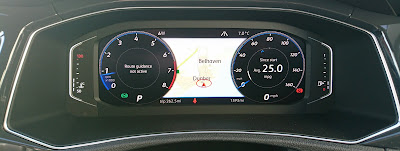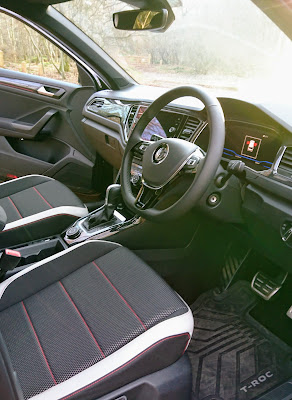The VW T-Roc was introduced last August, becoming the fourth vehicle in the Volkswagen SUV lineup. Slotting in a niche just below the Tiguan in size, the T-Roc sits somewhere between the Nissan Qashqai and Juke in terms of its size, and is Volkswagen’s entry into the hotly-contested compact SUV segment.
Prices for the Volkswagen T-Roc start at £18,950, which will get you a manual SE-spec car with VW’s 1.0 TSI petrol engine, front wheel drive and 115PS.
The model I tested was the top-of-the-range SE-L, which features a 2.0 TSI petrol engine with an output of 190PS (187hp). That power reaches the wheels via Volkswagen’s 7-speed DSG automatic gearbox and is transmitted to all four wheels using 4Motion all-wheel-drive.
 |
| My Tweet teasing the T-Roc's arrival (on Twitter.com/Jack_McMotors) went over a lot of peoples' heads... |
First Impressions
On collecting the T-Roc from Specialist Cars Volkswagen Kirkcaldy, I was faced first with the task of getting to grips with the technology on board. The model I drove came fitted with Volkswagen’s Active Info Display dashboard, which replaces the traditional dials and readouts ahead of the driver with a high-resolution 10.3” colour display.
This allows the driver to cycle through several screen layouts displaying vehicle information, driver assistance system status, radio or media information and - most useful of all - a live sat-nav readout. Active Info Display shows the chosen information alongside traditional circular rev counter and speedometer, or can make it the main view for the driver (with speedo etc inset) into the sat-nav map or driver assistance systems, or any number of different layouts.
 |
| My go-to layout for the T-Roc's Active Info Display |
Having played around with the Active Info Display to my heart’s content, I blasted off from the dealership at Kirkcaldy to meander my way back towards East Lothian.
Out on the open road, the 2.0 TSI’s 187hp makes for a usefully gutsy drive, and at times it lures you into an odd sense that you’re not in such a big vehicle after all.
In a way you aren’t; the T-Roc is based on the same VW MQB platform as many VW cars, including the current Golf and, while the driving position is raised up over that car, its ‘sportily snappy proportions’ as VW describes them make it feel very agile. The T-Roc is in fact around 2cm shorter than a Golf hatchback, and around 20cm wider, bestowing it with a squat profile on the road. It’s not athletic - this is a compact SUV after all - but considering its stature its agility is impressive.
4Motion helps here too, working together with that powerplant to disguise the T-Roc’s height and 1495kg weight well on the road.
The run down from Fife also gave me time to get to know the T-Roc’s driver assistance systems a bit better. As I approached the Queensferry Crossing and traffic began to bunch up, the system latched on to a Mazda MX-5 ahead of me, and eerily matched its speed as we wafted across the bridge.
 |
| The T-Roc's radar-guided cruise control was eerily competent, but occasionally had issues with vehicles leaving the carriageway |
Over the course of the journey, I found the system to overall be scarily competent at latching on to and matching the vehicle in front’s speed, and only felt it begin to struggle a bit if the vehicle in front took an off-ramp from the motorway, which occasionally flummoxed the system a bit, causing it to stab the brakes briefly.
While crossing the, er, Crossing, I took in a bit more of the T-Roc’s interior. LED lights seem to have been used throughout the cabin, with soft light streaming from almost every nook and cranny. This is contrasted by red streaks of light that run along the glossy panels adorning the door cards, bathing occupants in a comforting glow. I found the effect quite successful as light levels dropped.
 |
| Rugged floormats hint at the T-Roc's appeal for outdoorsy types |
Off the beaten track
The run down from Kirkcaldy, while pleasant, didn’t give much opportunity to test the T-Roc’s range of skills; the roads were fairly straightforward, humdrum motorway-type fare.
It only seemed fair to try out the T-Roc in conditions that would show off more of its range of capabilities.
On paper, the T-Roc seems like the perfect companion for on-the-road nine-to-five Monday-to-Friday, with a few features to help with going off the beaten track so to speak over the weekend.
While it’s no Range Rover, and to be fair it doesn’t pretend it is, the T-Roc’s smidge of extra ground clearance over a Golf (161mm in the T-Roc vs 142mm in a Golf) can help give a bit of peace of mind if crossing a bit of a rutted track on your way to your outdoor pursuit of choice.
 |
| The T-Roc's smidge of extra ground clearance is helpful over slightly rougher terrain, which is great if you like to go hiking of a weekend |
The off-road setting softens up the T-Roc’s suspension, while the car works out the best way to maintain grip on loose surfaces. I tested the T-Roc over a rutted dirt track, where the car’s suspension coped admirably over the rough surface. Given the height of the drivers seat, some jiggling was inevitible, but overall I was impressed.
I also took the T-Roc up a short, muddy slope, and as each wheel began to lose grip I could feel the system cutting in and affecting the speed of each wheel as it started to slip - the off-road assistance is very active on the AWD T-Roc, and provides reassurance over surfaces where FWD cars could end up bogging down.
 |
| 4Motion AWD helps the T-Roc keep its composure over slippery surfaces |
After the mild off-roading, I headed back towards civilisation, switching from the pliant off-road setting to the T-Roc’s sport mode along a quiet stretch of B-Road.
This firms up the suspension, helping make the already-agile T-Roc extremely nippy - far more so than you might expect from the lofty driving position. The 187hp 2.0 TSI engine my car had propels it to 60mph in just 7.2 seconds and a top speed of 134mph, while AWD variants of the T-Roc get multi-link suspension that helps add to the sporty fizz and keeps the car composed on the twisty bits. On a spirited jaunt, it’s a hoot.
The T-Roc, in 2.0 TSI SE-L guise, has something of a split personality. It straddles a wide range of skills, from hot-hatch levels of on-road pace and poise, to comfortable motorway tech-fest, as well as its off-road adornments.
In this spec, the only criticism to level at it (other than the quality of some bits of the interior) is its fuel economy. Even in fuel-efficient ‘Eco’ mode, the highest fuel economy I saw with the Active Cruise Control turned on, on a (admittedly short) motorway run, was just over 32mpg. Switching to manual driving mode got this number above 38mpg.
The solution to this comes in the form of the 1.5 TSI T-Roc. This still has enough power to return a lively on-road experience (150bhp, good for a 0-60 dash of 8.1 seconds and top speed of 127mph) while bringing the fuel economy into the 50s - staggeringly close to both the 150bhp diesel and the 115PS 1.0 TSI also available in the range. CO2 emissions are fairly low too, at 121g/km with the six-speed manual and 123g/km with the 7-speed DSG gearbox - vs 155g/km for the 2.0 TSI.
With the customisation options Volkswagen offers - including interior trim colours to match the vibrant selection of exterior paint - as well as both FWD and AWD variations and a plethora of onboard tech, the Volkswagen T-Roc tries hard to deliver something for everyone across its range.
VW T-Roc prices start at £18,950 on the road for a basic 1.0 TSI petrol in S trim, rising to £31,485 for a top-of-the-range 2.0 TSI 4Motion in SE-L spec, as tested here.
This puts it up against everything from the Renault Captur, Dacia Duster and Vauxhall Mokka at the lower end of its price range, all the way up to the likes of the Mercedes-Benz GLA, Mini Countryman and VAG-relation the Audi Q2 at the upper reaches.
Special thanks to Specialist Cars Volkswagen Kirkcaldy for letting me borrow the Volkswagen T-Roc.

No comments:
Post a Comment